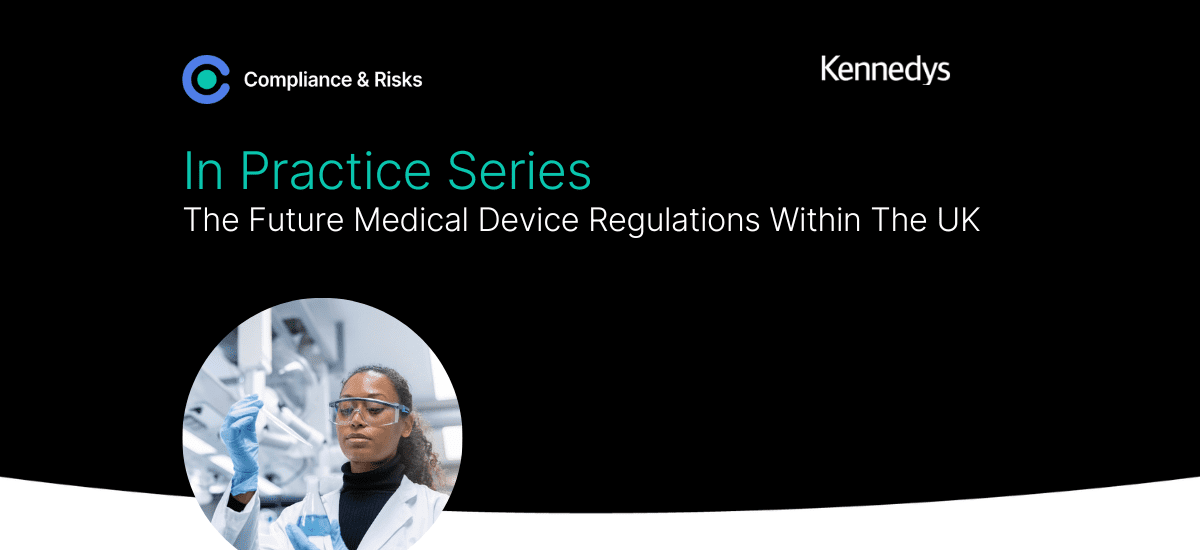
The Future Medical Device Regulations Within The UK

Our monthly “in practice series” is brought to you in partnership with Kennedys law LLP
to help ensure you have access to practical insights backed by our comprehensive, in-depth regulatory expertise.
Authored by: Sarah-Jane Dobson, Partner, thomas panter, senior Associate, Miran Bahra; Associate and Clarisse Patel; Litigation Assistant Kennedys Law llp
On 26 June 2022, the UK’s medical device regulator, the Medicines and Healthcare products Regulatory Agency (MHRA) published their response to the consultation on the “future regulation of medical devices in the UK”, which indicates future wide-reaching change for the UK medical devices regulatory regime going forward.
Introduction
In the UK, medical devices are currently regulated under the Medical Devices Regulations 2002 (“MDR 2002”), which gave effect in UK law to the following EU Directives (which have since been repealed and replaced at EU level):
- Directive 90/385/EEC on active implantable medical devices;
- Directive 93/42/EEC on medical devices;
- Directive 98/79/EC on In Vitro Diagnostic (IVD) medical devices.
Following the UK’s exit from the EU and the sweeping reform of the medical device regime currently being undertaken at an EU level, the MHRA has noted that there is now a unique opportunity for the UK to review the MDR 2002 (which is based on EU retained law) and improve how medical devices and IVD medical devices are regulated in the UK post-brexit.
As part of this, the Medicines and Medical Devices Act 2021, which came into force on 11 April 2021, vests power in the MHRA to allow them to make amendments to the existing regime in the UK, the MDR 2002.
The Consultation
As a first step, on 16 September 2021, the MHRA published a consultation seeking the views of patients, medical device researchers, developers and manufacturers to help shape the future regulations on medical devices. The MHRA’s response to the consultation, which as noted above was published on 26 June 2022, confirmed that the UK’s future Medical Device Regulations will be based on the following five “pillars”:
- Strengthening the MHRA’s powers to ensure that patients are kept safe;
- Making the UK a focus for innovation, in particular in respect of developing and introducing innovative medical devices;
- Addressing health inequalities and mitigating biases throughout the medical device product lifecycle;
- Building synergies with both EU and global standards through the use of proportionate regulation which supports businesses; and
- Setting world leading standards – Building the UKCA mark as a global exemplar.
In conjunction with the above, the MHRA announced on the 25 October that the UK’s future Medical Device Regulations will likely be in force by July 2024; following a 12 month extension to the original implementation deadline. This extension is seen to allow time for both the industry and regulator alike to prepare for what are significant regulatory changes for the life sciences industry without compromise to the safe supply of medical devices in the UK. We currently await the draft text to the UK’s future Medical Device Regulations and will comment further upon receipt of the same.
Whilst the extension has given the sector greater breathing room, it is an opportune time to revisit the proposed future changes for device manufacturers and stress test preparedness.
The UK’s Future Medical Device Regulations
The MHRA’s response to the consultation sets out the current intention for the UK’s future Medical Device Regulations, which includes the following changes:
| Section | MHRA Intentions |
|---|---|
| Scope of Medical device and IVD | Broaden the scope to cover products which are similar to medical devices in terms of their functioning and risk profile, but for which a manufacturer claims only an aesthetic or another non-medical purpose. This will result in a suite of products, including dermal fillers for example, being subject to stricter requirements. The MHRA has confirmed that they will provide updated guidance in respect of the regulation of ‘borderline’ products to reflect any changes made in the future Medical Device Regulations. |
| Products without an intended medical purpose | Require manufacturers of high-risk devices to publish data on device safety and performance following UKCA marking. |
| Classification of general medical devices | Change the classification of certain medical devices and bring further products within the scope of the classification rules. In particular, the following products, which will be up-classified to Class III: -active implantable medical devices and their accessories. -substance-based devices used in vitro in direct contact with human embryos before implantation or administration into the body. -surgical meshes. -total or partial joint replacements (with exceptions). -spinal disc replacement implants and implantable medical devices that contact the spinal column (with exceptions). -medical devices that are composed of substances or of combinations of substances that are intended to be introduced into the human body. -active therapeutic medical devices with an integrated or incorporated diagnostic function such as closed loop systems or automated external defibrillators. Introduce changes to ensure that the regulation of software as a medical device is clear, effective, and proportionate to the risks that medical devices present. |
Essential requirements for medical devices | Introduce a requirement to list ingredients or component parts which are known allergens or sensitizers (for example, natural rubber latex and chlorhexidine). |
| Manufacturer obligations – measures for recompense | Introduce a requirement for manufacturers to have measures in place, for example, sufficient financial coverage, for providing compensation to those impacted by adverse incidents with medical devices on the UK market. |
| Health Institutions | Introduce a requirement for health institutions to register medical devices that have been manufactured or modified ‘in house’. |
| Claims | Introduce requirements for claims made about medical devices to ensure that any such claims accurately reflect the safety, performance and intended purpose of the medical device. |
| Quality Management Systems (QMS) | Require all medical device manufacturers, including manufacturers of Class I devices, custom-made devices, IVD medical devices to apply an appropriate QMS. This requirement will also apply to health institutions. |
| UK responsible persons | Include an explicit requirement for the UK responsible person to have an address in the UK at which they are physically located. Clarify that the UK responsible person is as legally liable for defective medical devices as the manufacturer. |
| Obligations of importers and distributor | Introduce obligations on importers and distributors to support better accountability, transparency and safety within supply chains. |
| Qualified persons | Require that manufacturers have available within their organisation at least one qualified person with qualifications or regulatory experience that exceeds the minimum standards set out in the future Medical Device Regulations. |
| Unique device identification (UDI) | Require manufacturers to assign UDIs to medical devices before they are placed on the market in alignment with other jurisdictions, such as the EU. |
| Registration of medical devices | Extend the data required in order to register medical devices in the UK, to enhance transparency. Require manufacturers to provide the MHRA with the relevant global medical device nomenclature for their medical device as part of device registration. |
| Clinical evaluation | Introduce requirements to the entire equivalence on a biological, technical and clinical basis. This will take the UK beyond the equivalence requirements in the EU Medical Device Regulations. |
Post Market Surveillance | Clarify and strengthen the requirement for manufacturers to implement a post-market surveillance system. |
| Trend reporting | Require the reporting of any statistically significant increase in the frequency or severity of incidents/erroneous results. |
| Analysis of serious incidents and field safety corrective action | Require manufacturers to issue field safety notices (FSNs) and to set out the minimum requirements for the content of the FSN. |
| Re-manufacturing single-use devices | Regulate the re-manufacturing of single-use devices, including packaging and instructions requirements which clearly state that the single-use device is re-manufactured and providing the identity of the re-manufacturer. |
A key theme arising from stakeholder responses to the consultation was that the UK’s future Medical Device Regulations should align with the EU Medical Devices Regulation (2017/745) (“EU MDR”) to avoid duplicative or divergent requirements and to facilitate the ongoing supply of medical devices to the UK market. Under the World Trade Organisation Technical Barriers to Trade agreement, the Secretary of State will be required to share the draft text of the UK’s future Medical Device Regulations for comment at least 60 days prior to the regulations being laid in Parliament. We will continue to monitor whether this draft text will in fact align with the EU MDR or whether the UK will pave the way for their own unique regulatory regime going forward.
Transitional arrangements
As noted above, the UK’s future Medical Device Regulations are scheduled to take effect by July 2024, following a 12-month extension to the original anticipated date of force. That being said, the MHRA has confirmed that a phased introduction of the new requirements will take place, including:
CE and UKCA Marked Devices | Manufacturers will be able to continue to place CE marked devices on the Great Britain market after 1 July 2023. From July 2024, the transitional arrangements will apply for CE and UKCA marked devices placed on the UK market. |
| Clinical Investigations | Clinical investigations which commence under the MDR 2002 before 1 June 2024 will be able to carry on provided that any additional reporting requirements set out in the future regulations are met, such as in respect of serious adverse events or device deficiencies. |
Checklist To Limit Risk:
[Downloadable version Here]
Companies should always refer to the specific regulations and guidance in place. However, the following general principles may provide some helpful pointers for staying on the right side of the law (subject to any subsequent draft text of the UK’s future Medical Device Regulations being published):
- Manufacturers should undertake a “readiness” review of their product portfolio to include an analysis of the implications of the UK’s future Medical Device Regulations on device classification and ensure that their medical device conforms with the device’s classification assessment. Manufacturers should use the response document to the consultation as a guide of the changes that will be implemented in the UK.
- Manufacturers whose products are not currently in the scope of the MDR 2002 or who are at risk of a change in classification, should consider whether they may now be brought into the scope and, whether their product meets the more stringent requirements. This is particularly the case for borderline products and aesthetic products claiming no medical purpose. The latter would include dermal fillers, which will now be classified as a medical device.
- There remains a relatively small number of UK approved bodies for carrying out conformity assessments and it is understood that current lead times are long. Therefore, steps should be taken now to put in place assessments where required.
- Manufacturers must have in place an appropriate QMS. Although the MHRA have expressed that they will be providing further guidance on specific requirements, stakeholder responses to the consultation have confirmed that the requirements should align with the EU MDR, EU IVD Regulation and ISO 13485.
- Manufacturers should take steps to ensure that they have, within their organisation, at least one qualified person with qualifications or regulatory experience that exceeds minimum standards that would be set out in the UK’s future Medical Device Regulations. It is the MHRA’s intention to require that SMEs have a qualified person permanently and at their continual disposal to ensure that appropriate regulatory support will be available to them.
- Manufacturers should ensure that their post-market surveillance meets the strengthened requirements which will be outlined in the UK’s future Medical Device Regulations.
- Developing and maintaining good ongoing relationships with the MHRA and conformity assessment bodies will ensure manufacturers are better placed to respond to future regulatory changes.
- Consider and create unity between any newly implemented EU requirement, where possible, to limit differing risk profiles across the regions.
Stay Compliant With Global Regulations
Catch up with our previous editions of our In Practice Series –
- How To Avoid “Greenwashing”,
- How To Be An ESG-Conscious Product Manufacturer,
- How To Get Ready For The New Product Liability Laws In Europe
- How To Prepare For The Upgraded Digital Services Laws In Europe
- How To Mitigate The Growing Risk From Consumer Class Actions And Collective Redress In Europe
Book Time With Our Team
Learn how C2P can help you stay ahead of regulatory changes globally and achieve uninterrupted market access.


